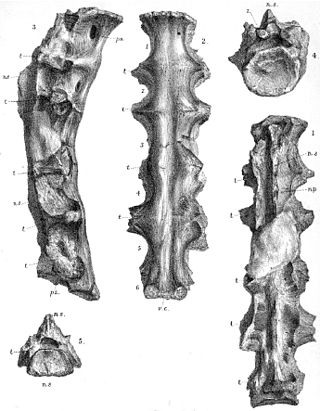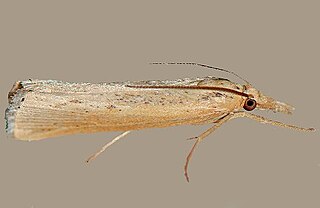
The Isle of Wight is an island, English county and unitary authority in the English Channel, 2 to 5 miles off the coast of Hampshire, across the Solent. It is the largest and second-most populous island in England. Referred to as "The Island" by residents, the Isle of Wight has resorts that have been popular holiday destinations since Victorian times. It is known for its mild climate, coastal scenery, and verdant landscape of fields, downland, and chines. The island is historically part of Hampshire. The island is designated a UNESCO Biosphere Reserve.

Valdosaurus is a genus of bipedal herbivorous iguanodont ornithopod dinosaur found on the Isle of Wight and elsewhere in England, Spain and possibly also Romania. It lived during the Early Cretaceous.

Polacanthus, deriving its name from the Ancient Greek polys-/πολύς- "many" and akantha/ἄκανθα "thorn" or "prickle", is an early armoured, spiked, plant-eating ankylosaurian dinosaur from the early Cretaceous period of England.

The shark is a moth of the family Noctuidae. The species was first described by Carl Linnaeus in his landmark 1758 10th edition of Systema Naturae.
HM Prison Parkhurst is a Category B men's prison in Parkhurst on the Isle of Wight, operated by His Majesty's Prison Service. Parkhurst prison is one of the two formerly separate prisons that today make up HMP Isle of Wight, the other being Albany.

Ornithodesmus is a genus of small, dromaeosaurid dinosaur from the Isle of Wight in England, dating to about 125 million years ago. The name was originally assigned to a bird-like sacrum, initially believed to come from a bird and subsequently identified as a pterosaur. More complete pterosaur remains were later assigned to Ornithodesmus, until recently a detailed analysis determined that the original specimen in fact came from a small theropod, specifically a dromaeosaur, making it one of the first dromaeosaurs known to science. All pterosaurian material previously assigned to this genus has been renamed Istiodactylus.

Copromorphidae, the "tropical fruitworm moths", is a family of insects in the lepidopteran order. These moths have broad, rounded forewings, and well-camouflaged scale patterns. Unlike Carposinidae the mouthparts include "labial palps" with the second rather than third segment the longest. With other unusual structural characteristics of the caterpillar and adult, it could represent the sister lineage of all other extant members of this superfamily. The genus Sisyroxena from Madagascar is also notable for its unusual venation and wing scale sockets.

Chelis is a genus of tiger moths in the family Erebidae. There are more than 30 described species in Chelis, found in the holarctic.

The map-winged swift is a moth belonging to the family Hepialidae and has a patchy distribution throughout Eurasia. The species was first described by Charles De Geer in 1778. It was previously placed in the genus Hepialus and some references still place it there.

Euplagia quadripunctaria, the Jersey tiger, or Spanish flag, is a diurnal moth of the family Erebidae. The species was first described by Nikolaus Poda von Neuhaus in 1761. The adult wingspan is 52–65 millimetres (2.0–2.6 in), and they fly from July to September, depending on the location. They tend to fly close to Eupatorium cannabinum.
Anatralata is a genus of moths of the family Crambidae. It contains only one species, Anatralata versicolor, which is found in North America, where it has been recorded from California to Idaho and British Columbia. The habitat consists of mountainous areas and low-elevation grasslands along the coast of central California.
Kasania is a monotypic moth genus of the family Crambidae described by Leonid Konstantinovich Krulikovsky in 1910. It contains only one species, Kasania arundinalis, described by Eduard Friedrich Eversmann in 1842, which is found in Poland, Ukraine and Russia.
Neocataclysta is a genus of moths of the family Crambidae. It contains only one species, Neocataclysta magnificalis, the scrollwork pyralid moth, which is found in North America, where it has been recorded from Florida, Georgia, Maine, Massachusetts, Mississippi, New Jersey, New York, North Carolina, Nova Scotia, Ohio, Ontario and South Carolina.

Udea is a genus of snout moths in the subfamily Spilomelinae of the family Crambidae. The genus was erected by Achille Guenée in 1845. The currently known 216 species are present on all continents except Antarctica. About 41 species are native to Hawaii.
Odontivalvia is a genus of moths of the family Crambidae. It contains only one species, Odontivalvia radialis, which is found in North America, where it has been recorded from Texas.

Perispasta is a genus of moths of the family Crambidae. It contains only one species, Perispasta caeculalis, or Titian Peale's pyralid moth, which is found in North America, where it has been recorded from Quebec west to British Columbia, south to Florida, Texas and Colorado. The habitat consists of fields and meadows. Both the genus and species were first described by Philipp Christoph Zeller in 1875.

Tehama is a genus of moths of the family Crambidae. It contains only one species, Tehama bonifatella, the western lawn moth, which is found in Greenland and North America, where it has been recorded from Alberta, British Columbia, California, Colorado, Labrador, Manitoba, Nevada, Quebec and Washington. The habitat consists of grasslands.

Euchromius ocellea, the necklace veneer or belted grass-veneer, is a cosmopolitan migratory species of moth of the family Crambidae, first described by Adrian Hardy Haworth in 1811. It has Hodges number 5454.

Euxoa adumbrata, the sordid dart, is a moth of the family Noctuidae. The species was first described by Eduard Friedrich Eversmann in 1842. In North America it is found across northern Canada from Quebec to western Alaska, south to the northern parts of the United States, and in the mountains to Colorado. It is also found in Greenland, the coastal areas of Scandinavia and the Ural. It was recently recorded from Denmark, although this includes Euxoa lidia, which some authors regard to be a valid species.

Vectiraptor is a genus of dromaeosaurid dinosaur from the Barremian aged Wessex Formation of the United Kingdom. The type and only species is Vectiraptor greeni, known from associated dorsal vertebrae and a partial sacrum.















